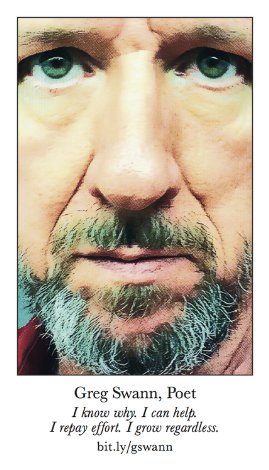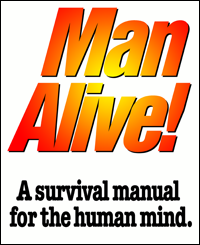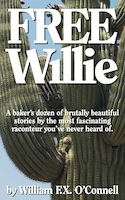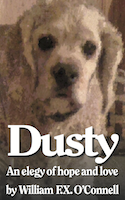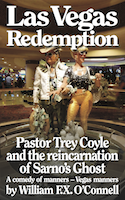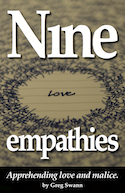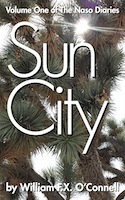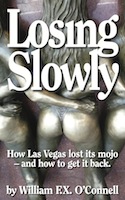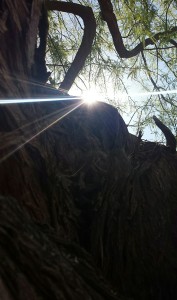
By now, I hope you know that the proper rejoinder to a ludicrous proposition put forth by a government functionary wearing a lab coat is to say, at full voice, “Say WHAT?!?” Don’t be shy. You’re not being anti-intellectual – very much the contrary. Instead, you are defending the mind against a reductionist labyrinth of compartmentalized madness. As soon as you ask any breathless theorist to connect his claims to the whole of existence – as soon as you demand to see an ontologically-consonant correspondence to realty – you will find out if he actually knows something, or if he is simply posturing for politicians and journalists.
Chapter 8. The integrity of art.
The universe is internally self-consistent. This is what we mean when we say it “makes sense” – the laws of nature are comprehensible to us because they are all consistent with each other, all superficially differentiated manifestations of the law of identity. This is actually a matter of controversy right now in theoretical physics, where the self-consistency of the universe and humanity’s seemingly uncanny adaptation to it are held to be evidence – in the mother of all We-Now-Know-We-Know-Nothing theories – that there is not merely one universe, but, the physicists claim, as many as ten to the five-hundredth power universes.
I am not making this up. I’m inclined to think that there can be only one everything-that-exists, and that, where the math does not conform to the observed evidence – where the map does not correspond to the territory – it is probably not the evidence that is incorrect. And doubt you nothing, the theologians are dancing in the streets: No longer are they the only madmen insisting that the cosmos consists of the products of their fevered imaginations. They get to play the Even-Physicists-Agree card over and over again, to the detriment of clear thinking everywhere.
But even stipulating the physicists’ claims, in the massively redundant cosmos prescribed by these theories there will be at least ten to the five-hundredth power instantiations of William of Ockham around to demonstrate the awesome detergent power of the law of parsimony. It can’t make black swans white again, but there is nothing like it for day-to-day clean-up of those nasty intellectual messes.
Academics don’t like to be mocked, and contrary to all appearances, they are not actually trying to invite derision. But when they insist that everything is really nothing or that science proves that science proves nothing or that the one tiny piece of existence that one of them studies is actually everything-and-then-some, just about anything they say is going to sound absurd. That’s a good thing, though – for you.
By now, I hope you know that the proper rejoinder to a ludicrous proposition put forth by a government functionary wearing a lab coat is to say, at full voice, “Say WHAT?!?” Don’t be shy. You’re not being anti-intellectual – very much the contrary. Instead, you are defending the mind against a reductionist labyrinth of compartmentalized madness. As soon as you ask any breathless theorist to connect his claims to the whole of existence – as soon as you demand to see an ontologically-consonant correspondence to realty – you will find out if he actually knows something, or if he is simply posturing for politicians and journalists.
Here are some examples of my style of intellectual guerrilla warfare: Every time I read about yet another Dancing Bear theory, I burn with urge to ask the theorist if his claim would be a good scam to get his mom into bed – you know, since she’s really no more than an animal, and it’s no big deal if I pull one over on her. When a neuro-scientist insists that the human mind is useful only in the production of errors, I want to offer to discuss his ideas at length, but not until he is being prepped for surgery. And if there really are ten to the five-hundredth power universes, I want to know why we can’t live in the one where professional intellectuals earn their keep by producing real economic value in the open marketplace, rather than by writing outrageous exaggerations for government grant proposals – which are then echoed and blown still further out of proportion by clueless, credulous journalists.
This kvetching illustrates why satire is inherently tragic, by the way. Comedy moves from left to right on the number line as the story progresses and resolves, from worse to better. Tragedy moves from right to left, from better to worse. Making fun of the chaos in academia may incite laughter, but indulgence in black humor is not a virtue – so I’ll stop. Instead, I will demonstrate the self-consistency of the universe – the integrity of everything-that-exists – by talking about art.
“Say WHAT?!?”
Everything-that-exists is all one thing. The universe is self-consistent because it cannot not be self-consistent – not without contradicting itself. Human beings and all other organisms are astoundingly well-adapted to life on Earth because – it would be rude to say “Duh!” – we evolved on Earth. The art that we make for each other is self-consistent to the universe because we are self-consistent to the universe.
Here is a very simple song I wrote, expressed in guitar or piano chords: G Em Am D (that is, G-major, E-minor, A-minor, D-major). I swear I didn’t steal that song, even though you can find that exact same chord progression in hundreds of pop tunes. Play it moderately fast in waltz time, six strokes of each chord in half-notes before you move onto the next, repeating indefinitely.
What is it that you’re hearing? It’s the musical equivalent of the three-act comedic structure: Establishment, complication, further complication, resolution. Major chords sound happy to our ears, minor chords sound sad, and in a very simple sequence of chords we can tell a story that anyone can understand. You have read that story in dozens of novels and seen it enacted dozens more times on Broadway and in the cinema, and it is that correspondence to this familiar literary narrative structure that makes it work so perfectly in popular music – especially love songs.
I wrote some illustrative lyrics for it, to further gild this particular lily:
First there is a situation
But now it’s turning sour
Now it’s getting even worse
But somehow it all works out
That’s awfully close to meta-philosophy for me, so please don’t fink me out to the post-modernist thought police. But everything-that-exists is all one thing, and it is easy, or it should be, to tell the truth in every form of Fathertongue at once. This is what opera does, and what light opera and musical comedy do, as subsets of the operatic canon. This is what the score of a film is doing, what the dancers in a ballet are doing, and what the sets and costumes for every sort of performance art are doing. A well-crafted work of art is telling the same one story in every form of Fathertongue it deploys.
And when I talk about Mothertongue and Fathertongue, I know that many people are straining to divide them up in their minds, to separate them and to regard them somehow as being opposites. This is understandable – it’s the way our minds like to work, in distinct categories – but it is incorrect. A genetic Homo sapiens becomes a human being when he masters Fathertongue, but none of us ever stops communicating in Mothertongue.
For one thing, since Mothertongue consists of bodily expressions of internal emotional states, we are “communicating” in Mothertongue all the time – even when we are all alone. For another, Mothertongue is necessary to many types of human social concourse – when we want to communicate love or hate, affection or indifference, trust or suspicion, admiration or contempt, reverence or ridicule, pride or shame, satisfaction, boredom, fascination, derision, impatience, joy, anger and countless other emotions. For still another, Mothertongue is essential to demagoguery and other forms of deception: I can say one thing – or a noisome nothing – in words and simultaneously communicate a different idea in facial expressions, verbal intonations or bodily posturing. And for still one more thing, Mothertongue is the essence of art.
“Say WHAT?!?”
All art is Fathertongue first, since all art is conceived and recorded in a notation system. But the purpose of a work of art is to induce in the audience – that would be you – the visceral experience of an emotional catharsis, entirely a Mothertongue phenomenon, in the dry, dusty, drab language of Fathertongue. The artist seeks to create as an artifact of the mind a reality more tellingly perfect, more viscerally true than the true reality of everyday existence. How like a god is that?
Do you doubt me? You are living proof of my thesis. More precisely, right now you are living in a living proof of my thesis.
This book is an artifact of my own self-adoration, which is the kind of integrity I look for and love in everything. This is what integrity means to me: Each discrete thing is different in its way, but everything-that-exists is all one thing, each entity or action or attribute or effect itself an expression of the same one thing – the law of identity. I like it that the world aligns that way. It would anyway, of course, but still I am delighted that, as a secondary consequence of the profound integrity of the universe, I get to live the philosophy I write by writing the philosophy I live. And because I work very hard to tell the truth beautifully, this is very much a work of art for me. Facts are facts and discursive prose is never more than words on paper, and yet it is a thing of ineffable wonder – to me, at least – that the true is the good is the beautiful.
And so I write that way – always. I am not a demagogue. I am not trying to fool you by sweeping you up in your emotions, whipping you into a thrilling but ultimately empty cathartic lather while I empty your wallet – and your mind – of every value your life truly requires. To the contrary, I am telling you the truth of the uniquely-human life in the best way I know how – and that includes writing the truth of moral goodness in the most beautiful way I can.
If you study the architecture of this treatise – the sequence of the arguments, the structure of each chapter, the rhythms of the paragraphs, the cadences of the sentences, the consonance – the sounds – of the word choices – you will learn a great deal about how to write persuasive prose. But this is art, not just discourse, because I am trying to deliver to you the Mothertongue experience of the psychic rewards – the Splendor – that will accrue to you when you learn to think as I do. I don’t want simply to tell you about the life of the mind I live, nor even just show it to you. I want for you to live it – from the inside, just as I do – even if only for the short while you will spend with this book.
I don’t know that I will have improved any life but my own, now or ever. But I know that what my life is now is a direct consequence of the things I have written in the past, and I know my life will be infinitely better because I have written this book. Whatever you get from my writing, if anything, I’m getting everything I hoped for and more. You cannot fathom the depths of my gratitude for the gift of mind. I make it my business to live up to it in every way I can. And by writing this way, by bringing you along with me as I soar from from one thoroughly-intellectualized emotional catharsis to the next, I am doing everything I can to persuade you to live up to the gift of mind as well.
And that is the integrity of the universe expressed in the integrity of art.

